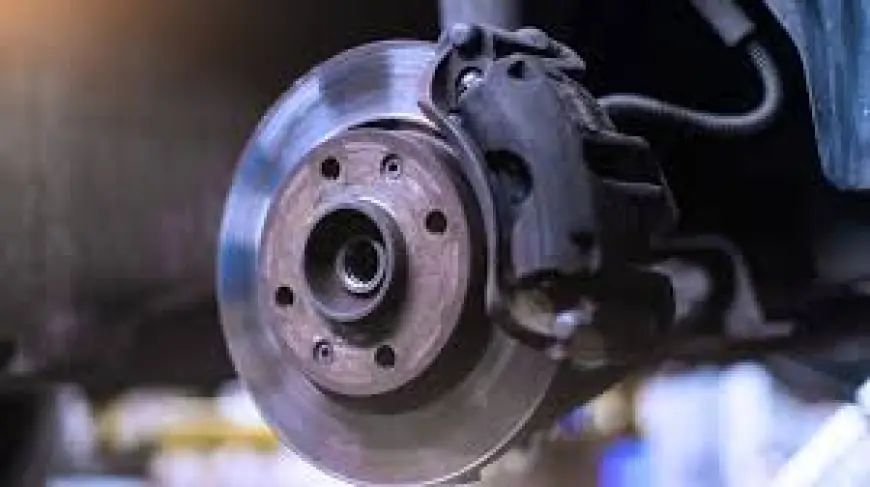Global Automotive Brake Caliper Market 2030F Growth Drivers
Technological advancements play a pivotal role in shaping the market landscape. The integration of electronic and sensor-based technologies into vehicles influences the design and functionality of brake calipers.

According to a recent TechSci Research report, “Automotive Brake Caliper Market – Global Industry Size, Share, Trends, Competition Forecast & Opportunities, 2029F”, the Global Automotive Brake Caliper Market was valued at USD 10.24 Billion in 2023 and is anticipated to grow at a CAGR of 7.95% between 2025 and 2029.
Brake calipers are critical components of a vehicle’s braking system, designed to apply pressure on brake pads, ensuring effective stopping power. Their importance in maintaining road safety, performance, and vehicle stability has fueled strong demand across both OEM (Original Equipment Manufacturer) and aftermarket channels. With global vehicle production on the rise, increasing focus on road safety regulations, and rapid advancements in lightweight materials and electronic braking technologies, the brake caliper industry is poised for robust growth.
Industry Key Highlights
- Market size in 2023: USD 10.24 Billion
- Forecast CAGR (2025-2029): 7.95%
- Growth driven by rising vehicle production, stricter safety standards, and lightweight caliper innovations.
- Increased use of aluminum alloys and carbon composites in caliper production.
- Expansion in both OEM and aftermarket segments across global markets.
- Growing influence of electric vehicles (EVs) and hybrid vehicles requiring specialized braking solutions.
- Strong regional demand from Asia Pacific, North America, and Europe.
Download Free Sample Report: https://www.techsciresearch.com/sample-report.aspx?cid=20547
Market Drivers
1. Rising Global Vehicle Production
One of the primary drivers of the automotive brake caliper market is the growing production of vehicles worldwide. With rapid urbanization, rising disposable incomes, and increased demand for passenger and commercial vehicles, global vehicle sales are climbing steadily. Each new vehicle requires a robust braking system, and calipers play a central role in ensuring safety.
2. Stringent Safety Regulations
Governments across major automotive markets are implementing stringent vehicle safety standards. Brake calipers integrated with ABS (Anti-lock Braking Systems), ESC (Electronic Stability Control), and traction control systems are becoming mandatory in many regions, fueling demand for advanced braking solutions.
3. Lightweight and Durable Materials
Manufacturers are focusing on reducing vehicle weight to improve fuel efficiency and reduce emissions. This has led to the adoption of lightweight brake calipers made from aluminum alloys, magnesium, and carbon composites. These not only enhance braking performance but also align with sustainability goals.
4. Rise of Electric & Hybrid Vehicles
The growing adoption of EVs and hybrid vehicles has created new opportunities for brake caliper manufacturers. EVs often incorporate regenerative braking systems, which require calipers with higher responsiveness and electronic integration, driving innovation in caliper designs.
5. Aftermarket Growth
As the global vehicle parc ages, the aftermarket segment for replacement calipers continues to expand. Wear and tear of brake components necessitate regular replacements, creating steady demand. The availability of performance-oriented upgrades and remanufactured calipers is further fueling aftermarket sales.
Emerging Trends
1. Integration of Electronic Brake Calipers
The evolution from hydraulic to electronically controlled brake calipers is a major trend, especially with the rise of EVs. These calipers offer faster response times, better energy efficiency, and improved integration with vehicle electronics.
2. Sustainable Manufacturing Practices
With sustainability becoming central to automotive innovation, manufacturers are adopting eco-friendly production methods and recyclable materials in brake caliper production, reducing their environmental footprint.
3. Focus on High-Performance Vehicles
The popularity of performance cars and sports vehicles is driving demand for high-strength, precision-engineered calipers capable of withstanding extreme conditions. Brembo and other premium manufacturers are leading this segment.
4. Regional Shifts in Production
Asia-Pacific is emerging as the largest automotive hub, especially with China and India increasing vehicle output. Simultaneously, North America and Europe are focusing more on safety innovation and premium caliper technologies.
5. Digital Supply Chain & Customization
Digital platforms and advanced supply chain networks are enabling faster customization of calipers for OEMs and aftermarket clients. Consumers can now access performance-based caliper upgrades more easily.
Market Segmentation Insights
By Sales Channel
- OEM (Original Equipment Manufacturer): Driven by rising global vehicle production and integration of advanced braking technologies at the manufacturing stage.
- Aftermarket: Gaining momentum due to aging vehicles, frequent replacement needs, and the availability of performance upgrades.
By Product Type
- Fixed Brake Calipers: Offer enhanced performance and durability, widely used in high-performance vehicles.
- Floating Brake Calipers: More cost-efficient and lightweight, commonly adopted in passenger cars.
By Vehicle Type
- Passenger Cars: Largest demand segment due to mass adoption worldwide.
- Light Commercial Vehicles (LCVs): Increasingly adopting advanced braking systems for logistics and urban mobility.
- Heavy Commercial Vehicles (HCVs): Require heavy-duty calipers capable of withstanding higher loads.
Regional Analysis
Asia Pacific
- Dominates global demand due to China, India, Japan, and South Korea being leading automotive producers.
- Strong growth in electric vehicle adoption enhances opportunities for advanced braking technologies.
North America
- Strong automotive base in the United States and Canada.
- High adoption of safety regulations and performance braking systems.
Europe & CIS
- Driven by stringent vehicle emission norms and safety standards.
- Germany, Italy, and France are hubs for premium automotive and caliper innovations.
South America
- Growing demand in Brazil, Argentina, and Chile, supported by aftermarket expansion.
- Rising middle-class consumers boosting passenger vehicle sales.
Middle East & Africa
- Emerging automotive hubs in Saudi Arabia, UAE, and South Africa.
- Investments in automotive infrastructure fueling brake component demand.
Competitive Analysis
The market is characterized by strong competition with key global players focusing on innovation, product durability, strategic collaborations, and global expansion.
Leading Companies
- Akebono Brake Industry Co. Ltd.
- Aisin Corporation
- Continental AG
- ZF Friedrichshafen AG
- Robert Bosch GmbH
- Brembo N.V.
- HL Mando Corp
- Alliance Automotive Holding Limited
These companies are investing in R&D, expanding their global manufacturing footprint, and forming alliances with OEMs to capture larger market shares. Brembo, for example, remains dominant in high-performance calipers, while Bosch and Continental focus heavily on safety-integrated braking systems.
Future Outlook
The global automotive brake caliper market is expected to continue its upward trajectory through 2029, fueled by increasing vehicle production, electrification trends, and evolving safety regulations.
- EVs and hybrid adoption will demand electronic and lightweight calipers.
- OEM and aftermarket integration will continue to drive revenue streams.
- Asia-Pacific will remain the largest contributor, while North America and Europe will focus on high-tech caliper solutions.
- Innovation in materials (carbon composites, magnesium alloys) will play a crucial role in reducing weight and enhancing efficiency.
Despite challenges such as pricing pressures and supply chain disruptions, the industry outlook remains strong, with opportunities in both developed and emerging markets.
10 Benefits of the Research Report
- Provides in-depth market size, share, and growth projections.
- Offers a comprehensive analysis of market drivers and restraints.
- Identifies emerging trends shaping the automotive caliper market.
- Highlights regional market dynamics and growth opportunities.
- Provides detailed segmentation by product, vehicle type, and channel.
- Covers competitive landscape and company strategies.
- Assists businesses in identifying investment and partnership opportunities.
- Supports strategic decision-making with data-backed insights.
- Addresses aftermarket opportunities and consumer behavior.
- Helps stakeholders anticipate future market challenges and solutions.
Conclusion
The Global Automotive Brake Caliper Market is entering a transformative phase, driven by vehicle production growth, EV adoption, technological innovation, and regulatory pressure. Brake calipers, once seen as a purely mechanical component, are evolving into smart, lightweight, and electronically integrated systems that not only ensure safety but also enhance vehicle efficiency.
As manufacturers and suppliers adapt to the changing landscape, opportunities in both OEM and aftermarket segments remain vast. Companies that embrace innovation, sustainability, and partnerships will lead the way in shaping the next era of braking technology.
Contact Us-
Mr. Ken Mathews
708 Third Avenue,
Manhattan, NY,
New York – 10017
Tel: +1-646-360-1656
Email: [email protected]
Website: www.techsciresearch.com
What's Your Reaction?
 Like
0
Like
0
 Dislike
0
Dislike
0
 Love
0
Love
0
 Funny
0
Funny
0
 Angry
0
Angry
0
 Sad
0
Sad
0
 Wow
0
Wow
0



















































